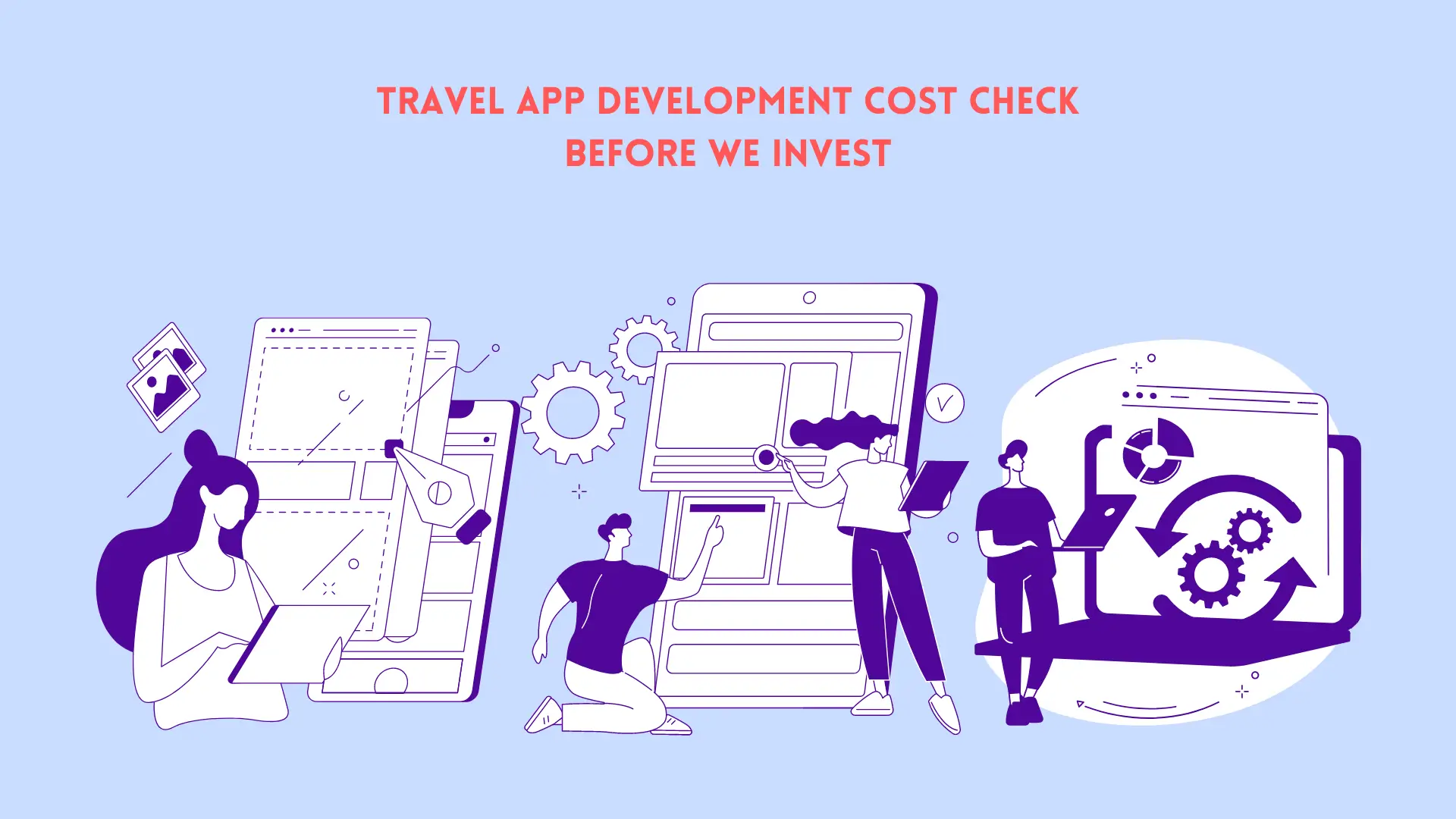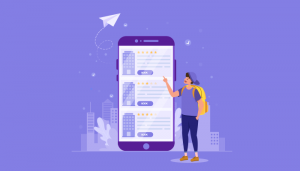
The development of a travel application is a great option for service companies in the tourism industry. Most travelers prefer apps over mobile apps due to their expanded functionality and the potential for offline access.
The travel app development cost
Creating a minimum viable product (MVP) with a limited set of options is priced between $15,000 to $75,000 and is usually completed in two to four months. Making a full-featured, complex travel app is more costly and takes a lot of time, so anticipate longer development time and higher prices starting at $100,000.
These costs represent an approximate range because the final price depends on the combination of features, the platform you choose, and the developer’s prices.

There are mobile apps for everything, and travel services are not exceptions. Users rely on mobile travel apps to book trips, make reservations for flights, and even accommodation. The numbers are impressive such as 71% of smartphone users use their phones to travel, and they do it at least once per week.
These factors will be discussed more in-depth later within the report. First, let’s look at how people’s travel habits have changed.
Travel Trends: New Opportunities For the Industry
The tourism industry was struck severely by the Covid incidents, worldwide pandemics, and regional lockdowns. Tourism sector expenditures fell by $8.1 trillion compared to before the outbreak of Covid.
Companies across the globe are reporting revenue losses following several years of steady growth. The habit of traveling is now ingrained into our lives so that even during the toughest restrictions, people were able to travel out of the country. Airlines offered flights, and hotels continued to welcome visitors, even subject to certain limitations and restrictions.
Even though our routine travel habits were radically altered, travelers came up with various travel apps to help their travel. Virtual travel, for instance, was a huge trend.
Virtual Tours
Virtual tours of World Heritage Sites skyrocketed during the initial lockdowns. They remain popular with visitors.
Today, travelers can book online tours of popular galleries and museums and enjoy stunning views of famous landmarks such as Mount Everest or Teotihuacan, and even walk digitally through the streets of any city in the world, all by simply having a mobile device in their hand.
With apps like Google Cardboards and Sites in VR, users can visit the most well-known monuments and natural marvels. A VR app is one of the ten emerging app developing trends that went one step further and offered snorkeling and virtual skydiving.
Rural Tourism
A second trend that is expected to be popular in 2022 will be the rise of local and rural tourism. People are more conscious of local destinations and are involved in outdoor activities like biking, hiking, or camping.
The trend towards domestic travel is apparent all over the world. Americans, for instance, think that camping is among the safest travel options in the event of a pandemic. Because of this, companies that focus on rural tourism, such as Snaptrip, are seeing increasing demand. These apps let travelers rent boats, cars, and camper vans and book lodging in rural areas.
Personal Approach
What else are we likely to see from the travel industry in the coming years? We’ll probably observe group travel declining in popularity, as more people prefer private travel and expect to receive a more personal service.
The top travel brands provide personalized customer service and experience through their user experience (UX) and user interface (UI). Data analysis and collection lets brands offer recommendations based on the customer’s past interactions on digital platforms.
Trip Flexibility
Another major market demand is trip flexibility. Since the global situation could remain uncertain for a long time, travelers can expect flexible travel plans and no-cost cancellation of bookings.
Future of Travel? No Worries
The sector has already begun a slow recovery, and experts are generally positive regarding the direction of travel. Some experts say that we can anticipate an increase in international travel.
In these times, mobile app development for travel companies plays an important part in the industry’s recovery by restoring our faith in travel and aiding us to adjust to the new norm.
If you are planning to purchase a travel app, taking a comprehensive look at the current and future trends in travel is crucial to ensure that you offer the specific product that the user wants.
Making an MVP initially with just one or two key features will allow you to try out the idea of your app and get an initial response from the audience. If successful, an MVP can be further developed into a fully-fledged web development app. What are the features most important in an MVP?
Travel App MVP Features
- Many travel apps are designed to meet the various purposes of travel. Certain apps have a limited range, like Google Maps, which works for route planning and navigation, and Meetup, ideal for local events, TripIt is for multi-purpose trip planners.
- The successful app for travel MVP can resolve the issues of the user. For instance, a booking MVP should have basic filters, search, and integrated payment methods. Users can look for travel options according to their preferences and then pay for their reservations through the application.
- When you’ve tested the available product, it is possible to add advanced filters, multilingual support, global currency support, and other features available in booking apps.
- In addition to booking apps, travelers use trip planners and itinerary generators. They are fantastic tools for managing every aspect of your trip.
- TripIt is among the more well-known tour organizers. This intuitive application allows users to build a detailed itinerary from customers’ reservations. It also provides users with immediate notifications of any cancellations or changes.
- A majority of apps for planning trips have the same concept, but they serve different purposes for travel. The app in the air guides travelers through the entire journey by reminding users of the gate the estimated arrival time, check-in and baggage suggestions, and so on.
- Apps such as PackPoint and DUFL focus on packing, and RoadTrippers can be extremely helpful in planning your road trip and finding places, attractions, and interesting places to stop in the process.
- The examples above are complicated fully-featured, multi-functional applications that perform numerous features. As we’ve said before, an MVP should only have two or three functions to solve users’ issues. Features such as finding itineraries and creating plans are the most important features for apps that manage travel.
- The itinerary provides a complete sketch of a trip that includes everything from getting on the plane to arriving at the hotel. It can also include points of interest, attractions, eateries, and other tourist destinations. The itinerary can be designed either manually or automatically. TripIt is one example. It requires users to forward all reservations that have been confirmed and then analyze the information and create the itinerary.
- Navigation and route planning are the most important functions, and therefore maps should be integrated into the stage of MVP.
- Let’s say that you have a general idea for your MVP and its primary features. Now you have to choose an appropriate business model for desktop applications. It is advisable to think about your investment return ahead of time, and here are a few suggestions for monetization.
How To Monetize Your Travel App
If you’re looking to make an income from your mobile app, then you’ll need to come up with a good way to monetize your app. There are a variety of monetization strategies that can be used for travel apps. The most common is the purchase cost for the first download. In this instance, the app must provide enough value or provide unique features to encourage users to purchase.
Paid subscriptions, where users pay for apps, offer a different method of monetizing. However, the app’s exclusivity and value have to justify the price. Otherwise, customers will be reluctant to pay for it regularly.
If the models you’re considering aren’t compatible with your app’s idea, Consider the most well-known strategies for monetization described below.
Premium Features
The majority of apps provide basic downloads and free downloads at no cost. App developers earn a profit by charging users an additional amount for upgraded premium services.
There are a lot of additional features to offer travelers, such as the upgraded version of TripIt gives specific information about each country, monitors refunds for possible fare cancellations, and provides members with immediate alerts.
Advertising
Advertising on the mobile app is among the most used methods. In the case of applications for travel, this performs extremely effectively, as you can rent advertising space to companies associated with the tourism business. Users will get information related to the search query, such as tour operator advertisements, hotels within their desired country, and airline promotions.
For instance, you could receive $0.10 for the most basic display of a banner, whereas the cost of a video advertisement can get you between $5 and 10.
Commission Fee
Another way to make money from traveling apps is through affiliate commissions. With this method, you determine an amount for each reservation that a user makes, regardless of whether it’s a flight, hotel, or tour reservation. In certain apps, the fee is set. Hopper, for example, charges $5 for every flight booked.
Cost of Travel App Development
The majority of your revenue comes from downloads and traffic. The more people utilize your application, the more revenue they make.
However, here’s a crucial question: what platform is best to start your app, and which one has more possibilities in terms of numbers of users and, in turn, improved returns on investments (ROI)?
iOS Vs. Android – Which one has a More Return on Investment?
- As far as market shares, Android has been the top platform globally since 2016. At the finish of the second quarter of the year 2020, the total number of downloaded files through both the Apple and Google Play stores was 35.7 billion.
- Google Play downloads accounted for more than 28 billion in the time. However, when it comes to revenues, the App Store more than doubled Google Play’s revenue for the quarter ending in 2020’s second quarter, as per Apple Insider.
- The development process is more complex for Android due to the dispersion of Android devices. This factor is why creating an Android application can be more laborious than creating an iOS application.
- This aspect is the same on both platforms regarding the cost estimate. However, developing an Android application may be more expensive due to the time element.
- If you want to operate the app on both platforms but have a limited budget, you could save money by creating a cross-platform application using Flutter and React Native technologies. For more in-depth information about development costs, read our posts on the development cost:
Price of Android App Development: Why Choose Android and How Much it Costs
App Developer Rates
Developers’ salaries vary based on the developer’s location and the complexity of the team. You can employ one full-stack developer for an income of between $10,000 and $20,000. Or, assign your project to an entire team of experts in an app development firm.
To create a high-end middle-complexity travel software, you’ll require an expert team like us.
Knowing the hourly rate of developers is helpful, but it’s not enough to give an accurate view of the total project cost. It is better to think about the cost of a single sprint.
Sprints are a 2-week development period during which an agreed list of development tasks occurs. Based on the estimates of salaries, the typical cost of a sprint is around $20,000 to $25,000. The amount of sprints needed is contingent on the app’s level of complexity.
The overall process for developing apps includes pre-development work, UX design, discovery, front-end and back-end, and quality assurance (QA) tests.
Designing the frontend and backend is the longest stage and may take anywhere between 6 and 24 weeks, depending on the level of complexity. The product’s design and discovery typically require between 2 and 8 weeks, along with the QA process ahead of the launch.
Also, it is important to consider post-launch maintenance and support expenses, which, on average, represent 20 percent of your budget for development.
The Bottom Line
The travel app development cost is a wide spectrum, with elements like the complexity of features and integration with third-party companies forming the majority of your expenditure. While developing an android app, particularly a travel app, can be costly. However, there are plenty of opportunities for smart investors to profit from society’s evolving travel habits by designing an app that meets the specific needs of today’s travelers. Are you thinking of a travel-related app in your head? Contact us with a short description of your idea, and we’ll get on the phone with an estimate and more details about our offerings.

Dr.Supreena has published two international books in finance with the able guidance of her guide and department at Ethiraj College of Women, University of Madras during her PhD in Economics and Finance. She is the Recipient of Dr Vedagiri Shanmugasundaram (An Oxford Scholar) Award for Outstanding and Successful PhD Candidate from Ethiraj College for Women concerning research record and academic distinction. She is experienced in the domain of finance, digital marketing and information technology writing on Artificial Intelligence, IoT, PaaS and SaaS cloud computing etc. She is NIIT qualified in Advanced Network Computing, Google Certified in digital marketing. Her hobbies to maintain balance and reduce stress are gardening and cooking.

